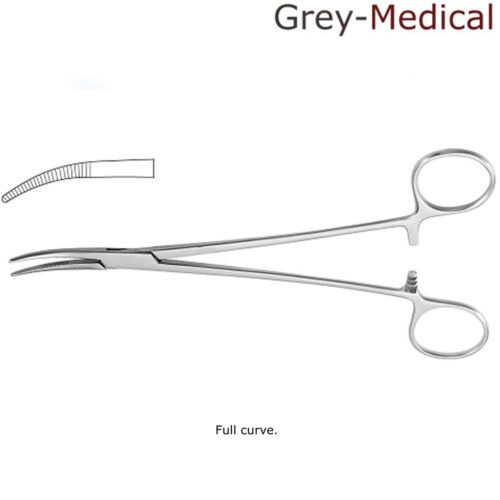Schnidt Hemostat: A Crucial Tool in Surgical Procedures
Schnidt Hemostat: A Crucial Tool in Surgical Procedures
Blog Article
The Schnidt hemostat, also known as the Schnidt tonsil clamp or Schnidt artery forceps, is a versatile surgical instrument widely used in various medical specialties. Its design allows surgeons to clamp blood vessels, hold tissues, and assist in delicate procedures with precision and ease. The Schnidt hemostat is especially renowned for its application in tonsillectomies and other head and neck surgeries, making it a staple in operating rooms worldwide. This blog explores the features, applications, and significance of the Schnidt hemostat in surgical practice.

What Is a Schnidt Hemostat?
The Schnidt hemostat is a curved, fine-tipped instrument with a long shank and a ratcheted locking mechanism. Made from high-quality stainless steel, the tool is durable, corrosion-resistant, and able to withstand repeated sterilization. The curved tip of the Schnidt hemostat is serrated, providing a secure grip on tissues or blood vessels without causing damage.
The instrument’s design makes it ideal for reaching deep and confined spaces, particularly in the oral cavity or neck. The ratchet lock enables the surgeon to clamp vessels or tissues securely without continuous manual effort, ensuring efficiency during lengthy procedures.
Applications of the Schnidt Hemostat
The Schnidt hemostat is used in a wide range of surgical procedures due to its precision and adaptability. Its primary applications include:
- Tonsillectomy
One of the most common uses of the Schnidt hemostat is in tonsillectomy procedures. The instrument is used to clamp the tonsillar pillars, hold tissues, or control bleeding during the removal of the tonsils. - Vascular Surgery
The Schnidt hemostat is frequently used to clamp blood vessels, particularly small arteries or veins, to control bleeding or isolate vessels during vascular procedures. - Head and Neck Surgery
In head and neck surgeries, the Schnidt hemostat is invaluable for its ability to navigate confined anatomical spaces. It is often used to hold or dissect tissues and control bleeding in these delicate areas. - General Surgery
In general surgical procedures, the Schnidt hemostat is used to clamp tissues, dissect planes, or handle sutures. Its versatility makes it a valuable tool in abdominal, thoracic, and other types of surgeries. - Gynecological Procedures
The Schnidt hemostat is also used in gynecological surgeries to control bleeding or hold tissues during procedures such as hysterectomies or laparoscopic surgeries. - Dental and Oral Surgery
In dental surgeries, the Schnidt hemostat may be employed to hold soft tissues or control bleeding during procedures involving the oral cavity.
Features of the Schnidt Hemostat
The design of the Schnidt hemostat is tailored for precision and ease of use in surgical settings. Key features include:
- Curved, Fine Tips: The curved and serrated tips allow the instrument to securely grip small blood vessels or tissues, ensuring precision in confined spaces.
- Long Shank: The extended length of the instrument makes it ideal for reaching deep into surgical fields.
- Ratcheted Locking Mechanism: The locking system enables the surgeon to clamp tissues or vessels securely without needing constant pressure, reducing hand fatigue during prolonged procedures.
- Ergonomic Handle: The handle is designed for comfort and control, ensuring steady manipulation of the instrument.
- Durable Construction: Made from surgical-grade stainless steel, the instrument is resistant to corrosion and designed for repeated use.
Importance of the Schnidt Hemostat in Surgery
The Schnidt hemostat is an essential instrument in surgical practice due to its versatility and precision. Its ability to clamp blood vessels and hold tissues without causing significant trauma ensures better surgical outcomes and reduced complications. In procedures like tonsillectomies or vascular surgeries, the instrument plays a critical role in minimizing blood loss and maintaining a clear surgical field.
Additionally, the ergonomic design of the Schnidt hemostat enhances the surgeon’s control and efficiency. The ratchet locking mechanism allows the instrument to be secured in place, freeing the surgeon’s hands for other tasks and ensuring a smoother workflow during surgery.
For delicate procedures in confined anatomical spaces, the Schnidt hemostat provides the precision and accessibility needed to navigate complex structures. Its reliability and adaptability make it a trusted tool across multiple surgical disciplines.
Advancements in Schnidt Hemostat Design
Modern advancements in surgical instrument design have further improved the functionality of the Schnidt hemostat. For instance, some versions now feature tungsten carbide inserts on the tips, enhancing the instrument’s grip and durability. Lightweight models made from titanium have also been introduced, reducing hand fatigue during lengthy procedures.
Disposable Schnidt hemostats are now available for single-use applications, ensuring sterility and minimizing the risk of cross-contamination. These innovations reflect the ongoing efforts to enhance surgical instruments for contemporary medical practice.
Conclusion
The Schnidt hemostat is a cornerstone instrument in surgical practice, offering precision, versatility, and reliability in a wide range of procedures. From controlling bleeding to holding tissues and navigating confined spaces, this instrument plays a critical role in ensuring successful surgical outcomes.
As technology continues to evolve, the Schnidt hemostat remains a trusted and indispensable tool for surgeons worldwide. Its ergonomic design, durable construction, and adaptability make it a vital component of any surgical toolkit, reflecting the importance of well-designed instruments in advancing modern medicine. Whether in general surgery, vascular procedures, or ENT surgeries, the Schnidt hemostat exemplifies the precision and innovation that define contemporary surgical practices. Report this page